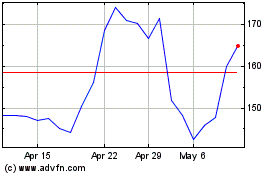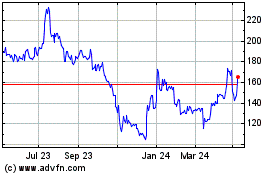Shippers Evergreen, Hapag-Lloyd Seeking Megaships Worth $2.2 Billion
June 20 2019 - 12:24PM
Dow Jones News
By Costas Paris
Shipping lines Evergreen Marine Corp. of Taiwan and Germany's
Hapag-Lloyd AG are asking Asian yards in separate requests to build
a total of about 15 mega-container ships that would have a combined
value of around $2.2 billion.
The proposals signal a lull in new orders in the sector is
ending as carriers seek ever-bigger vessels to carry goods, and
will widen a gap between capacity and demand on container
shipping's critical Asia-to-Europe trade lanes, where operators
have been mostly losing money over the past five years.
Hapag-Lloyd, the world's fifth largest container operator in
terms of capacity, is sounding out yards in Japan, South Korea and
China for up to six ships that could each move 23,000 containers,
people with knowledge of the matter said. Evergreen, the
seventh-biggest player, is considering adding eight to nine ships
and that deal may be signed by the end of the summer, these people
said.
"Evergreen's order will come faster and Hapag-Lloyd will be
later," a person involved in the matter said.
The carriers are members of competing alliances that share ships
and port calls to cut costs. A typical one-way trip from Asia to
Northern Europe involves at least 10 port calls in which the
megaships drop off and take on new cargo.
"Some of the vessels are to fulfill capacity commitments within
the alliances and others to renew older and less efficient ships,"
a second person said. "Yes, there is overcapacity and the trade
picture does not look good with the tariffs and the economic
slowdown, but these ships will run for the next 25 years and now is
a good time to buy."
Taiwan's Yang Ming Marine Transport Corp. and China's Cosco
Shipping Holdings Co., the third biggest boxship operator, are also
looking for new ships but no orders are imminent, the people
said.
The orders would be the first for big ships in the container
shipping sector since last fall, when South Korea's Hyundai
Merchant Marine last October signed contracts for 20 vessels,
including 12 of the biggest ships that carry up to 23,000 20-foot
containers.
Demand for shipping consumer goods, manufacturing parts and
other anchors of global trade is waning this year on the back of a
slowing global economy and the yearlong tensions between the U.S.
and China. Maritime data provider Alphaliner in late May cut its
container volume growth estimate for this year to 2.5% from
3.6%.
Chinese shipping executives say they have withdrawn capacity in
the trans-Pacific route since the first round of U.S. tariffs were
introduced last summer.
Operators say they have little choice but to invest in new ships
despite a gloomy outlook because of stricter environmental
regulations kicking in early next year. Starting in January, all
oceangoing vessels will have to sharply reduce their sulfur
emissions, and maritime operators expect to slash greenhouse gas
emissions from ships by half in 2050.
"This means a lot of older ships will be scrapped because the
cost of retrofitting them to meet clean air standards will be too
expensive," the first person said. "We actually expect supply of
new ships to match demand by 2021, which is just around the
corner."
Write to Costas Paris at costas.paris@wsj.com
(END) Dow Jones Newswires
June 20, 2019 12:09 ET (16:09 GMT)
Copyright (c) 2019 Dow Jones & Company, Inc.
Hapag-Lloyd (TG:HLAG)
Historical Stock Chart
From Mar 2024 to Apr 2024

Hapag-Lloyd (TG:HLAG)
Historical Stock Chart
From Apr 2023 to Apr 2024
